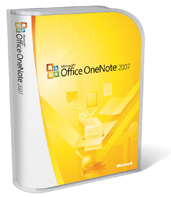 Several weeks ago I spotted the Microsoft Across America RV in the parking lot of our building. There was no way I was going to let a free opportunity to see some of the new technology Microsoft is selling go by. After a quick lunch, I headed out to their setup.
Several weeks ago I spotted the Microsoft Across America RV in the parking lot of our building. There was no way I was going to let a free opportunity to see some of the new technology Microsoft is selling go by. After a quick lunch, I headed out to their setup.
Inside their demonstration RV, they were featuring a few kinds of business technology, namely their LiveOffice website tools (complete with free domain names, web site, and email accounts) and the quick-scan business card reader. Although what impressed me the most was their demonstration of OneNote.
I’m not terribly familiar with all the functionality in OneNote, but it seems straightforward enough that I could sit down without reading any user guides and get the basic functionality down. But to get to the point of this entry, I want to focus on one killer feature of OneNote.
Rather than write hand-written notes on a pad of paper, advisers can adopt the use of a Tablet PC and OneNote. Advisers can use a stylus to write in all the client notes that he or she desires, and the handwriting recognition software will convert the notes to text (I tried out the handwriting lexicon and it seemed to work very well with my printing; handwriting is a bit more temperamental. Oh, and you can set a lexicon for each user that signs in to the Tablet PC, that’s pretty nice). No more scanning of handwritten notes that subsequently can’t be searched for content unless you have a fantastically robust OCR package.
In conjunction with the OneNote software, advisers can set up a microphone and record the audio of a client meeting. Why record the audio? When writing notes into OneNote, OneNote records a timestamp of when the entry was created. This timestamp can be used to effectively index into the audio recording. So how can one realistically use this?
Say that a client wants to buy a sports car. The adviser writes down that she wants a BMW. Quickly the subject changes and the meeting moves on. A few weeks later the adviser would like to send a follow up to the recent meeting and see if the client purchased the BMW. But what models were she considering? Colors? Other brands. All that was written down was the BMW. But use OneNote and the audio recording and one can jump to the point in time of the conversation where the discussion of the BMW came up, and playback reveals the names of the two models she was considering and how she compared them to Jaguars with similar features. Cool!
Not to mention that this can be a huge life-saver if one ever needed to retrieve dialogue from a meeting for compliance or discovery purposes. Although this sword cuts both ways; the recording could, if the advisor acted untruthfully; become evidence in a lawsuit where damages were awarded to a damaged client due to what was said in the meeting.
Nevertheless, I was fairly impressed with the ease of which this feature works. Add in video to the recording, and you have a full recreation of your client meeting. All it costs is some initial setup, a disclosure so you’re approved to record a meeting, and lots of cheap hard drive space. It could prove to be invaluable as advisers can quickly index to portions of any meeting where details were forgotten or interesting insights were not written completely.




